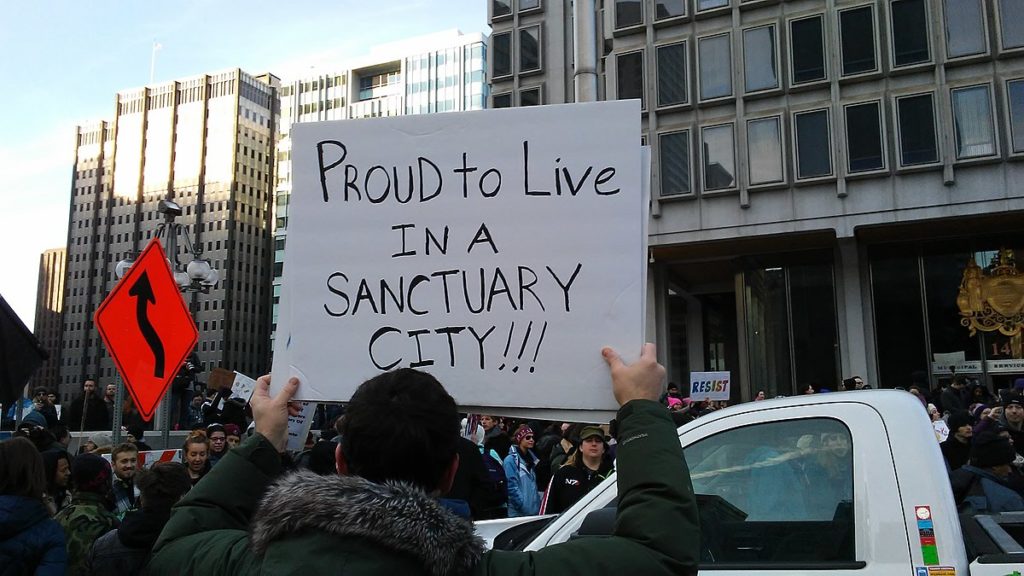
Throughout his 2016 presidential campaign, Donald J. Trump routinely described so-called sanctuary cities as posing a threat to public safety by harboring “criminal aliens.” He also characterized immigrants—particularly unauthorized Mexican immigrants—as criminals.
This xenophobic and anti-immigrant discourse resonated with a segment of voters and helped propel Trump into the White House.
Sanctuary ordinances are passed by cities to prohibit city employees from cooperating with the enforcement of Federal immigration law. In January 2017, President Trump signed Executive Order 13768, which withholds certain federal grants from sanctuary jurisdictions until they fully cooperate with the Federal government in the enforcement of immigration law (see Section 9(a)). In November 2017, a Federal judge found Section 9(a) of the executive order unconstitutional and issued a permanent injunction on its nationwide implementation.
According to several recent studies, there is no evidence that the implementation of sanctuary policies leads to violent crime.
Our analysis of violent crime in 107 cities contributes to this growing body of research. We found cities that adopt sanctuary ordinances experience a decrease in robberies. Moreover, among sanctuary cities, an increase in the relative concentration of unauthorized Mexican immigrants leads to a reduction in homicides. These results are contrary to the prevailing political discourse.
Trump’s political rhetoric and policy decisions raised several important questions that we addressed in our research. First, what exactly is a sanctuary policy? Second, does the implementation of such an ordinance in any way affect crime? Finally, is unauthorized immigration associated with increased crime?
Much of the existing literature on sanctuary policies comes from legal scholars and social scientists. These studies tend to focus on the conceptual definitions of such policies, how they operate in practice, and debates regarding the constitutionality of sanctuary ordinances.
To our surprise, empirical research on the topic of sanctuary cities and crime is relatively sparse. And while there is a substantial body of research finding a negative relationship between immigrants and crime, less work has focused on specific immigrant groups such as unauthorized Mexican immigrants.
What is a sanctuary policy?
The term sanctuary has led to much confusion among the public. This is perhaps because there is no official, federal definition of what constitutes a sanctuary. Rather, this is a colloquial term used to describe policies that limit the cooperation of local officials with federal authorities in the enforcement of immigration law.
A series of federal policy changes in the 1990s led to the increased involvement of local authorities in enforcement of immigration law. In response to these policies, as well as programs such as Secure Communities, several local jurisdictions throughout the country began adopting policies to limit the cooperation between local and federal authorities. These policies, which take a variety of forms, are often referred to as sanctuary policies.
But some scholars have argued that the term sanctuary is actually a misnomer. Immigration law is a federal matter; therefore, federal agents can enforce immigration law throughout the country—including in so-called sanctuary jurisdictions. Furthermore, most sanctuary cities do in fact cooperate with federal immigration agents when noncitizens have committed serious or felonious offenses.
Does the implementation of a sanctuary policy at the city level increase crime?
Through the course of our research, we found that the adoption of a sanctuary policy at the city level was not associated with increased violent crime. In fact, we find found the opposite to be true: the implementation of a sanctuary policy is associated with a subsequent decrease in robberies.
These findings come from statistical analyses based on publically available demographic and crime data for 107 U.S. cities with populations of 100,000 or greater. The findings from our study are consistent with those from prior studies in that there is no positive association between the implementation of sanctuary policies and violent crime.
Are unauthorized Mexican immigrants associated with violent crime?
There is a well-established literature of research assessing the relationship between immigrants, immigration, and crime. The overwhelming consensus among these studies is that immigrants and immigration are not associated with higher rates of crime. In fact, in some cities, immigrants may actually revitalize dilapidated neighborhoods thereby decreasing crime rates.
Nevertheless, hardly any studies have focused specifically on unauthorized Mexican immigrants, which is a group that Trump explicitly targeted on the campaign trail. Our research finds that an increase in the unauthorized Mexican immigrant population does not lead to higher violent crime rates. On the contrary, we find that homicide incidents actually decrease as the concentration of unauthorized Mexican immigrants increases, but only in cities with sanctuary ordinances.
What does this all mean?
Although there are relatively few studies examining the relationship between limited cooperation policies and crime, one thing is clear: there is no evidence that adopting such policies at the city level leads to an increase in violent crime.
We contend that immigration policy should be informed by empirical evidence; not shaped by moral panics or isolated incidents of violence committed by noncitizens.

No Comments